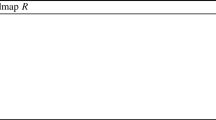Abstract
Unmanned aerial vehicles (UAVs) present in a wide range of scales, airframe types and possible systems configurations. Assessing how these different systems perform, therefore, should be an essential part of their design. This task, however, is particularly difficult due to the complex, dynamic interactions these vehicles are capable of, and the often complex operational conditions. In this paper we describe and apply an evaluation framework based on spatial cost-to-go (SCTG) maps. These maps describe the spatial distributions of optimal state and cost-to-go for a given geographical environment, and are computed using a finite-state approximation of the vehicle dynamics. The SCTG maps embed the interaction effects between vehicle dynamics and environment, and thus provide a rigorous basis for the evaluation of the airframe, various system and environment factors. The paper describes the results obtained applying this framework to a basic goal-directed guidance task taking place in an urban environment. Three small-scale UAV types are compared: a fixed-wing aircraft, a standard helicopter, and a quad-rotorcraft. Both minimum-time and minimum-energy performance criteria are analyzed to determine overall performance characteristics and highlight the basic features of the proposed framework.
Similar content being viewed by others
References
Evans, J., Messina, E.: Performance metrics for intelligent systems. NIST Special Publication, pp. 101–104 (2001)
Sukhatme, G., Bekey, G.: Multicriteria evaluation of a planetary rover. In: Proceedings of IEEE International Conference on Robotics and Automation, pp. 22–28 (1996)
Wong, S., Middleton, L., MacDonald, B., Auckland, N.: Performance metrics for robot coverage tasks. In: Proceedings of Australasian Conference on Robotics and Automation, vol. 27, p. 29 (2002)
Tunstel, E.: Operational performance metrics for mars exploration rovers: field reports. J. Field. Robot. 24(8–9), 651–670 (2007)
Pines, D., Bohorquez, F.: Challenges facing future micro-air-vehicle development. J. Aircr. 43(2), 290–305 (2006)
Costello, M.: Challenges facing micro air vehicle flight dynamics and controls engineers. 46th AIAA Aerospace Sciences Meeting and Exhibit. Reno, NV (2008)
Mettler, B., Kong, Z., Goerzen, C., Whalley, M.: Benchmarking of obstacle field navigation algorithms for autonomous helicopters. American Helicopter Society 66th Annual Forum. Phoenix, AZ (2010)
Hollands, J., Wickens, C.: Engineering Psychology and Human Performance. Prentice Hall (1999)
Rodriguez, G., Weisbin, C.: A new method to evaluate human-robot system performance. Auton. Robots 14(2), 165–178 (2003)
Cummings, M., Bruni, S., Mercier, S., Mitchell, P., et al.: Automation architecture for single operator, multiple UAV command and control. The International C2 Journal 1(2), 1–24 (2007)
Smithers, T.: On quantitative performance measures of robot behaviour. Robot. Auton. Syst. 15(1–2), 107–133 (1995)
Nehaniv, C., Dautenhahn, K.: Of hummingbirds and helicopters: an algebraic framework for interdisciplinary studies of imitation and its applications. In: Demiris, J., Birk, A. (eds.) World Scientific Series in Robotics and Intelligent Systems, Interdisciplinary Approaches to Robot Learning, vol. 24, pp. 136–161. World Scientific Press (2000)
Nehmzow, U.: Quantitative analysis of robot-environment interaction–towards scientific mobile robotics. Robot. Auton. Syst. 44(1), 55–68 (2003)
Kong, Z., Korukanti, V., Mettler, B.: Mapping 3D guidance performance using approximate optimal cost-to-go function. AIAA Guidance Navigation and Control Conference. Chicago, IL (2009)
Bellman, R., Dreyfus, S.: Applied Dynamic Programming. Princeton University Press
Mettler, B., Dadkhah, N., Kong, Z.: Agile autonomous guidance using spatial value functions. Control Eng. Pract. 18(7), 773–788 (2010)
Gibson, J.: The ecological approach to the visual perception of pictures. Leonardo 11(3), 227–235 (1978)
Mettler, B., Toupet, O.: Receding horizon trajectory planning with an environment-based cost-to-go function. In: Proceedings of IEEE Conference on Decision and Control, pp. 4071–4076 (2005)
Reif, J.: Complexity of the mover’s problem and generalizations extended abstract. In: Proceedings of the 20th Annual IEEE Conference on Foundations of Computer Science, pp. 421–427 (1979)
Hutchins, E., Lintern, G.: Cognition in the Wild. MIT, Cambridge (1996)
Kong, Z., Mettler, B.: On the general characteristics of 2d optimal obstacle-field guidance solution. IEEE Conference on Decision and Control. Shanghai, China (2009)
Bryson, A., Ho, Y.: Applied Optimal Control. Wiley, New York (1975)
Lynch, N., Segala, R., Vaandrager, F.: Hybrid I/O automata revisited. In: Domenica Di Benedetto, M., Sangiovanni-Vincentelli, A. (eds.) Hybrid Systems: Computation and Control. Lecture Notes in Computer Science, vol. 2034, pp. 403–417. Rome, Italy (2001)
Frazzoli, E., Dahleh, M., Feron, E.: Robust hybrid control for autonomous vehicle motion planning. In: Proceedings of IEEE Conference on Decision and Control, vol. 1 (2000)
Leishman, J.: Principles of Helicopter Aerodynamics. Cambridge Universtiy Prress (2006)
McCormick, B.: Aerodynamics, Aeronautics, and Flight Mechanics. Wiley (1995)
Mettler, B., Kong, Z.: Receding horizon trajectory optimization with a finite-state value function approximation. American Control Conference, pp. 3810–3816 (2008)
Mettler, B., Bachelder, E.: Combining on-and offline optimization techniques for efficient autonomous vehicles trajectory planning. AIAA Guidance, Navigation and Control Conference and Exhibit. San Francisco, CA (2005)
Fredman, M., Tarjan, R.: Fibonacci heaps and their uses in improved network optimization algorithms. Journal of the ACM (JACM) 34(3), 596–615 (1987)
Fox, R., McDonald, A., Pritchard, P.: Introduction to Fluid Mechanics. Wiley, New York (1985)
Chicone, C.: Ordinary Differential Equations with Applications. Springer, Verlag (2006)
Choset, H., Burdick, J.: Sensor-based exploration: the hierarchical generalized voronoi graph. Int. J. Rob. Res. 19(2), 96 (2000)
Zender, H., Jensfelt, P., Mozos, O., Kruijff, G., Burgard, W.: An integrated robotic system for spatial understanding and situated interaction in indoor environments. In: Proceedings of the National Conference on Artificial Intelligence, vol. 22, pp. 1584–1589 (2007)
Author information
Authors and Affiliations
Corresponding author
Rights and permissions
About this article
Cite this article
Kong, Z., Mettler, B. Evaluation of Guidance Performance in Urban Terrains for Different UAV Types and Performance Criteria Using Spatial CTG Maps. J Intell Robot Syst 61, 135–156 (2011). https://doi.org/10.1007/s10846-010-9485-9
Received:
Accepted:
Published:
Issue Date:
DOI: https://doi.org/10.1007/s10846-010-9485-9




